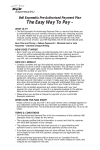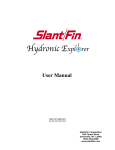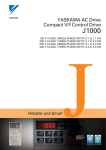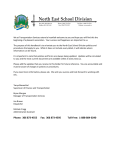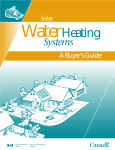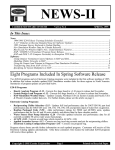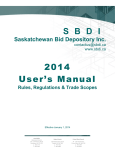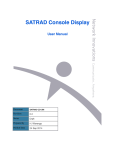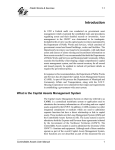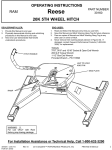Download Installation and Setup -- A 5 Step Process
Transcript
4 Installation and Setup -A 5 Step Process INTRODUCTION If you do not want to install your system yourself, you can have it installed by a professional. Ask your retailer for information about the installer in your area. (You will be given a toll-free number. Call the toll-free number and leave a message. The installer will call you back to set an appointment). If you do intend to install your ExpressVu™ system yourself, this chapter provides installation procedures. The procedures are relatively simple, but do require some skill in construction-related tasks. Be sure to follow all warnings and cautions; they are provided for your safety. An optional Installation Kit is available. This Kit includes typical hardware used during installation, and a more detailed Installation Kit Guide. Contact your ExpressVuTM dealer. It is important that you follow all local building codes and the electrical codes specified by your local electric company, as well as standard safety procedures for installing and working with this type of equipment. Improper procedures or installation can result in damage to the equipment or the building, and harm to you. If you are not sure about whether your installation follows these codes, contact a licensed building inspector or electrician in your area for assistance. Take extreme care to avoid contacting any overhead power lines, lights, and power circuits while you are installing the satellite antenna. Contact with any of these could prove fatal. Do not install the satellite antenna near power lines. See "Safety Instructions" on page iii for additional safety information. Page 4-1 User and Installation Guide DISCUSSION OF POTENTIAL MOUNTING SITES When you are surveying your property for appropriate sites for the satellite antenna, keep in mind that you can mount the satellite antenna on a variety of surfaces: brick, cinder block, wood, some sidings, rooftop, or a pole. Because installing the satellite antenna may involve drilling into the wall or roof of your building, or digging a hole and using cement, you should be very confident of the location before beginning installation. Errors can be expensive and time-consuming. The following guidelines apply to all mounting surfaces and locations. WEATHER AND WIND CONSIDERATIONS The satellite antenna has been built to withstand most kinds of weather. However, extremely strong winds could damage the base on which the satellite antenna is mounted. A strong wind can cause the satellite antenna to exert several hundred kilograms of pressure on the mounting surface, so the surface must be stable and strong. Such a mounting surface also helps ensure against movement of the satellite antenna, which would interfere with signal reception. In general, the stronger the signal you maintain, the better your chance of uninterrupted reception during periods of snow, rain, and heavy cloud cover. SOME KEY POINTS TO CONSIDER DO’S You should always follow these instructions to help ensure against injury to yourself and damage to your equipment or building. See "Safety Instructions" on page iii for further safety instructions. • Assemble the satellite antenna in a safe location before climbing up to the mounting location. Use caution when climbing, and when working at the mounting location. Depending on the mounting location and size of your dish, 2 people may be required to install the mount and antenna to your dwelling. • Install the satellite antenna only on a solid surface such as cinderblock, brick, or solid foundation material. If you install it on the side of a building, be sure to attach the bolts directly to a building stud or other solid material. Use the appropriate drilling and attachment hardware for the surface. • Make sure you have determined the best location for the satellite antenna before drilling the holes in your building or setting up the mounting pole. Mistakes can be costly. • All installations should conform to your local building and electrical codes. If you are not sure, contact a licensed building inspector or electrician in your area to assist you. Be aware that community covenants, if any, may have additional requirements. Page 4-2 Installation and Setup Discussion of Potential Mounting Sites 4 • Choose a site that is easily accessible in most weather conditions. You may need to clean snow, ice or debris off the satellite antenna. • Place the satellite antenna as close to the receiver as possible. We recommend using no more than 30 meters of cable between the receiver and the satellite antenna, unless you install a line amplifier to boost the signal. • Consider seasonal changes. The site may appear unobstructed in the winter, but spring and summer foliage could block the signal to the satellite antenna. DO NOTS You should always follow these instructions to help ensure against injury to yourself and damage to your equipment or mounting surface. See "Safety Instructions" on page iii for further safety instructions. • Never install the satellite antenna under power lines. • Do not install the satellite antenna where it can be jostled, bumped, or blocked by people, animals, or vehicles. • Do not install the satellite antenna where it is exposed to high winds. • Do not try to install the satellite antenna in windy or stormy weather, particularly if there is a chance of lightning. • Do not attempt to fasten the satellite antenna to the mortar between bricks or cinder blocks. • Do not mount the satellite antenna on vinyl or aluminum siding. These materials are structurally too weak to securely hold the satellite antenna, even with a building stud underneath. The siding would have to be crushed, or the forces of wind and weather over time would crush the area under the foot of the antenna mast. • Do not mount the satellite antenna downwind of a chimney or furnace vent. Ashes and dirt could collect on the dish and LNBF, possibly causing damage and poor reception. If practical, locate the antenna so the dish faces away from the vent. • Do not install the satellite antenna on stucco or imitation masonry unless the base material is solid. Do not mount the satellite antenna on composite materials such as strand, chip, fiber, or particle board unless the fastener attaches securely to a wall stud, rafter, or other foundation material beneath the surface. • Do not mount the satellite antenna on a railing, on a tile roof, or in a tree. Page 4-3 User and Installation Guide MOUNTING THE ANTENNA ON BRICK We define "brick" as a solid brick wall or other structure. This does not include brick facing that is used on some buildings over the main structure. If you are mounting the satellite antenna on brick facing, see "Mounting the Antenna on Siding," below. You can mount the satellite antenna on a solid brick wall. • The surface must be flat and even. • The mortar between the bricks should be in good to excellent condition. The satellite antenna foot should be mounted on several bricks. As the wind tugs on the satellite antenna, the foot will put heavy pressure (several hundred kilograms) on those bricks in different directions. Loose or weakened mortar may allow the bricks to shift, changing the dish angle and reception quality, and possibly damaging the satellite antenna and the building. The installed satellite antenna could also hasten the deterioration of old mortar. • To mount the satellite antenna on brick, be sure that all of the fasteners are set into the brick, not into the mortar between the bricks. Use materials necessary to follow the local building codes. MOUNTING THE ANTENNA ON SIDING We do not recommend mounting the satellite antenna on aluminum or vinyl siding. These materials can be structurally unsound, causing eventual shifting of the dish. To mount the satellite antenna on solid siding, be sure to follow the suggestions below. • The surface must be flat and even. You may need to use a separator, or shim, between the shingles to even the siding surface. • Mount the foot on the foundation material beneath the siding surface. This may be a building stud, cinder block, or other solid material. To locate the studs, find the vertical line of nails where the siding is attached to the building, or use a stud finder. Page 4-4 Installation and Setup Discussion of Potential Mounting Sites 4 MOUNTING THE ANTENNA ON CINDER BLOCK You can mount the satellite antenna on cinder blocks, whether they are part of a wall or the side of a building. • The surface must be flat and even. • If you are mounting the satellite antenna on a building, make sure that the surface is true cinder block, not just a block facing over another material. If you are mounting the satellite antenna on block facing, see "Mounting the Antenna on Siding" on page 4-4. • Be sure that the cinder block and mortar are in good to excellent condition. • We recommend using toggle anchors and machine bolts, inserted into the hollow of the block, as fasteners. Other types of anchors may not have the required strength. MOUNTING THE ANTENNA ON THE ROOF You can mount the satellite antenna on the roof. This usually provides the highest available location. • Attach the satellite antenna to a rafter beneath the roof surface. You can locate the rafter by looking for the nails attaching the fascia board to the rafters. You can also locate the rafters from inside the attic. Page 4-5 User and Installation Guide • Be sure that the location is easily accessible in most weather conditions. You may need to sweep off snow, remove debris, or clean dirt from the dish surface. • To prevent the roof from leaking, you should caulk the holes, or use silicone sealant around the holes and at the bottom of the satellite antenna foot where it contacts the surface. Apply the sealant before you bolt the foot down tight. • Place the antenna so it is not directly downwind from a chimney or furnace vent. Soot can gather on the dish surface, weakening the reception. If practical, locate the antenna so the dish faces away from the chimney. • Do not mount the antenna on a tile roof. MOUNTING THE ANTENNA ON WOOD You can mount the satellite antenna on a wooden deck, wooden beam, or other wooden surface. • The surface must be flat and even. • Be sure that the wood has a solid foundation, and is secured. It should be a strong piece that cannot be moved or jiggled. • Do not mount the satellite antenna on a railing. Page 4-6 Installation and Setup Summary Of Installation 4 SUMMARY OF INSTALLATION Following is a summary of the procedures to install and set up your ExpressVu™ system. We recommend that you perform the procedures in the order presented. 1. Unpack the satellite antenna, receiver, and parts (see pages 4-8 through 4-10) and the optional installation kit, if you purchased one (see page 4-9). 2. Review "What You Need to Know" (see page 4-9). 3. Connect the receiver to your TV set, and make sure the Smart Card is installed (see page 4-28). 4. Determine the approximate location of the ExpressVu™ satellite (see page 4-10). 5. Find the best location on your property for the satellite antenna, with a clear line of sight to the satellite (see pages 4-10 through 4-12). 6. Assemble the satellite antenna and attach it to a solid surface (see pages 4-12 through 4-26). 7. Ground the satellite antenna, and wire it to the ExpressVu™ receiver (see pages 4-38). 8. Aim the satellite antenna for the strongest possible signal (see pages 4-29 through 4-33). 9. Connect the receiver to an active telephone connection (see page 4-39). With the receiver wired to the TV and the antenna properly installed, you will be able to see the ExpressVu™ Program Guide, which tells you about available programs, channels, and services. 10.Order your programming by calling the ExpressVu™ Customer Service Centre at 1-888-SKY-DISH (see page 4-40). 11.Wire the receiver to your other electronic equipment (see page A-13). Page 4-7 User and Installation Guide STEP 1: BEFORE YOU START INSTALLATION This is a typical "Mount"shown attached to a wall. Notice that the top portion is "Plumb". THE KEY } Top TO SETTING UP YOUR SYSTEM EASILY – THIS IS IMPORTANT The key to setting up the system is in the accurate initial setting of the vertical elevation of the dish. The vertical elevation is the amount of tilt upwards, from horizontal, toward the sky, which is required to “see” the satellite. This is best achieved by mounting the dish support mast so that the top portion, to which the dish clamps attach, is as “Plumb” as possible. That is to say: the top portion of the mount should be as perpendicular to the earth as you can manage - this is true for wall mounting, roof mounting, any kind of mounting. If it is “Plumb“, then, when the dish is mounted on it and the dish is tilted upward toward the satellite at the correct vertical elevation angle, the dish can be easily panned (East/West movements) to find the satellite. UNPACK AND CHECK CONTENTS As you unpack the system, confirm that all the parts are included. See "Package Contents" below for a list of the included components. Note: Keep the shipping materials in which these items are packed, in case you ever need to return them. Unpack the contents carefully. Electronic equipment can be easily damaged if bumped or handled roughly. Examine all parts for damage that may have occurred during shipment. If you find any damage, immediately call the location where your ExpressVu™ system was purchased, or the Customer Service Centre at 1-888-SKY-DISH, before continuing with installation. The size of your dish will vary depending on the part of Canada in which you live. The standard diameter of a ExpressVuTM dish is 60 cm, however, 76 cm, 90 cm or 1.2m dishes are also available. If you require the large dish, we recommend that you hire a professional to install it because installation of the 90 cm and 1.2 m dishes is a more exacting project. Page 4-8 Installation and Setup Before You Start Installation 4 PACKAGE CONTENTS • User and Installation Guide • ExpressVu™ satellite antenna assembly • ExpressVu™ receiver • Accessories ❒ ❒ ❒ ❒ ❒ 7.6-metre RJ11 telephone cable 2.4-metre phono (RCA) 3-connector cable 1.8-metre modulator cable 2.4-metre S-VIDEO cable (optional) Remote control, with two (2) AAA batteries packaged separately In addition, we provide an optional Installation Kit, which includes the necessary hardware and cables that you would typically use during installation. Contact the location where your ExpressVu™ system was purchased for more information, or call the ExpressVu™ Customer Service Centre at 1-888-SKY-DISH for the location of a licensed dealer near you. WHAT YOU NEED TO KNOW Because you will make modifications to the location where you mount the satellite antenna, we suggest that you be familiar with and be able to safely perform the following procedures. • You should be able to use a plumb line or level to set both horizontal and vertical surfaces. This is especially critical for vertical surfaces. • You should know how to drill holes in the mounting surface (whether wood, brick, cinder block, etc.). • You should know how to drill holes and run cabling through your building. This includes sealing the holes once the cable has been installed. WHAT YOU NEED TO HAVE If you did not purchase the installation kit, you will need the following materials: • Coaxial cables and connectors (RG6 recommended up to 100ft. For longer distances consult a installer) • Fastening devices to attach the mount to your dwelling • Waterproofing for the outdoor connections • Grounding materials • Cable ties Page 4-9 User and Installation Guide You will also need some tools: A 7/16”,1/2”, 9/16” wrench (varies with dish size) A Phillips screwdriver A spirit level A drill and drill bits (masonry and wood) A compass INSTALL BATTERIES IN THE REMOTE Two AAA batteries, packaged separately, are included with the remote control. See "Install Batteries in the Remote" on page 2–4 for this procedure. STEP 2: FIND THE RIGHT LOCATION FOR THE DISH The Dish must be at a location on your dwelling which gives a clear, year-round, unobstructed “view” of the satellite and which is also free from occasional blockages due to vehicles or passers-by. Locating the appropriate site for your ExpressVu dish is a two step process: First, use your compass and the satellite direction data provided in this guide, to estimate the general direction of the satellite. Use this information to find the right spot to mount the dish on your dwelling. Next, get more serious about the installation; confirm that your dish has a clear unobstructed “view” of the satellite and that the dish can be mounted securely. ExpressVu’s current satellite is located 107.30 West Longitude. In late 1998, ExpressVu will begin transmitting from a new, more powerful satellite to be located at 910 West Longitude. When the new satellite becomes fully operational, all existing dishes will need to be moved to a new position in order to acquire the new satellite signal. The movement in question will involve a panning to left or right, and possibly tilting up or down of the dish. Note: The “Satellite Location Table” on page 4-34 contains information on locating the current and future satellite position.Using the figures in the these tables, it is recommended that you select a mounting location for your dish which will allow a clear, unobstructed line of sight to both satellites. If your circumstances prevent you from “seeing” both satellites from one location, but you are able to “see” both satellites from two different locations, it will be necessary to move the entire mast and dish assembly to the new location when the new satellite becomes operational. Page 4-10 Installation and Setup Find The Right Location For The Dish 4 WHAT YOU WILL NEED • • • • Compass Level Satellite Location Table (page 4-34) Vertical Elevation Protractor (page 4-37) DETERMINE DIRECTION TO THE SATELLITE You must determine the direction the ExpressVu™ satellite from your location to help you determine where to mount your antenna. You must have a clear line of sight from the antenna location to the satellite. Use the following procedure to find the best location for the antenna, while keeping in mind the considerations referenced in DISCUSSION OF POTENTIAL SITES on page 4-2. After you finish mounting the antenna, you will need to re-aim the dish to get the strongest signal. Please see STEP 5: ALIGNING THE DISH on page 4-29 for this procedure. WHERE IS IT? Our current satellite (ANIK E2) is in a stationary position some 40,000 km above the earth, directly above the equator about due South from Saskatoon. To determine if you have a clear view from your location to the satellite, look in the direction of the correct compass heading according to the table on page 4-34, using the information for the city nearest you. Facing this direction look up into the sky, at the angle above the horizon specified in the table (vertical elevation angle) starting on page 4-34. For example, in Calgary, look in the Southern sky at compass heading 1530 and 310 above the horizon. Usually, assessing whether or not you have a clear view of the satellite is as simple as observing the southern sky and estimating the possibility of an obstruction. Our current satellite is in a Southeastern direction from the Western Provinces, Southerly from the Prairies, and Southwesterly from the Maritimes. Finding the ExpressVu Satellite from Calgary ExpressVu Satellite 153 0 Page 4-11 User and Installation Guide To get a direction from a compass, set it on a flat, non-metal surface and rotate it until “North” is indicated on the dial under the needle. Now sight from the centre of the compass towards the angle of interest. From the installation location sight a distant object such as a tree or building, so that you have a convenient reference of the position of the satellite. FIND A CLEAR LINE OF SIGHT "Find a clear line of sight" means to find a location for the satellite antenna so that its view of the orbiting satellite is unobstructed by trees, buildings, or any other obstructions. This includes making sure that sapling trees are The Homemade Sextant not likely to grow up or out into the line of sight. Also, consider seasonal changes. An unobstructed Cardboard triangle copied from back cover site in winter may be obstructed by foliage in spring and summer. Cardboard Cutout If you need a way to determine if you have a clear “view” to the satellite, try this procedure: Cut out a cardboard triangle with its base about 8-10 inches long. Make the angle of the triangle equal to the vertical elevation angle for your location as given in the Table (page 4-34) or simply use the triangle as illustrated on page 4-37 as a template. Tape it to your level as shown in the sketch. Now you have a homemade sextant! Next, look up the edge of the cardboard while holding the level horizontal while aiming it at the correct compass heading. If there is an obstruction, locate the dish elsewhere. Level Using the Sextant STEP 3: ASSEMBLING THE DISH The following section outlines the assembly procedure for all four dish sizes: 60 cm, 76 cm, 90 cm, and 120 cm. The overall assembly procedure is similar for all four sizes, but there are some specific differences which are addressed in four separate sections. Please refer to the section which is relevant to the dish size you have purchased: • • • • Step 3.1 Step 3.2 Step 3.3 Step 3.4 Page 4-12 Assembling the 60 cm Dish Assembling the 76 cm Dish Assembling the 90 cm Dish Assembling the 120 cm Dish Installation and Setup Assembling the 60cm Dish 4 STEP 3.1: ASSEMBLING THE 60 CM DISH STEP 3.1A: PRE-ASSEMBLE THE PARTS (60 CM DISH) It’s best to pre-assemble the dish indoors, so that it is all ready to place on the mast outdoors, quickly and easily ... especially if it’s cold out. The complete system consists of three main parts: the dish mount, the dish assembly, and the receiver. The mount consists of the foot (base plate) and a bent pipe called the mast. These two parts are pre-assembled. The dish assembly consists of the antenna, or dish, the dish support bracket, the (LNBF) low noise amplifier, and the LNBF support arm. The receiver is also fully assembled. Dish Mount Mast LNBF Arm Pre-assemble the Dish as follows: 1. Bolt the dish to the support bracket and the support arm; there are clear instructions and pictures in the antenna box. Neck Collar 2. Mount the plastic LNBF assembly bracket on the LNBF arm as shown in the diagram. It should slide onto the end of the LNBF arm until it is stopped by the plastic tab. Fasten it with the screw provided. Curved Shoe M 3. Place the narrow neck of the LNBF into the curved shoe of the assembly bracket then place the capture collar over the neck and fasten it carefully and evenly with the two screws provided. Do not firmly tighten as further adjustments are required. The white plastic portion of the LNBF should face the dish. 4. Adjust the position of the LNBF to be as far back in the collar as possible. Do this by gently pulling the LNBF as far away from the dish as permitted by the LNBF and collar assembly. Rotate the LNBF so that the coaxial connectors are pointing down. This is the “6:00 o’clock” position for the LNBF rotation (please refer to the diagrams). BF LN AR LNBF Bracket Stops d sh LNBF LNBF ARM 5 o'clock 7 o'clock 6 o'clock Page 4-13 User and Installation Guide 5. Twist the angle of the LNBF slightly according to the Table (page 4-34). In Western Canada, the LNBF is in the 7:00 o’clock position; in Central Canada, it is in the 6:00 o’clock position and in Eastern Canada, it is in the 5:00 o’clock position. Vertical Elevation Gauge 6. Determine your specific vertical elevation from the Table (page 4-34) and adjust the angular tilt of the antenna so that the edge of the red mark on the gauge is set to your vertical elevation. In our diagram here, it is set for 38.5 degrees. 7. Lightly tighten the bolt on the gauge side of the angular pivot; leave the bolt on the back side slightly loose. 8. Your antenna assembly is now ready to be placed on the outdoor mount assembly. The mount for attaching the dish to the dwelling is made steel and, as a result, it is very magnetic. If you are too close, it can adversely alter your compass readings. STEP 3.1B: ATTACHING THE MOUNT TO YOUR DWELLING (60 CM DISH) The mount should be attached to your dwelling before putting the dish assembly on it. When fastening it to your wall or roof, etc., make sure that the top portion is “plumb”; you can get it right by using a spirit level on both the front and side of the top piece. It is important to affix the mount firmly to your structure with at least 4 fasteners so that the wind will not alter the direction of the dish. Note: Plumb means vertical in all directions. A flagpole is plumb. 90˚ WALL MOUNT Page 4-14 90˚ HORIZONTAL MOUNT 90˚ ROOF MOUNT Installation and Setup Assembling the 60cm Dish Here is how it can be done: SIDE VIEW 4 FRONT VIEW 1. Place the mount foot on the surface location where you intend to attach it to the structure. 2. Arrange the holes in the foot to be over solid material and adjust the top part of the mast to be approximately plumb. 3. Put your spirit level on the side of the pipe (see diagram) and move the foot slightly to make the PRESS LEVEL AGAINST MOUNT pipe vertical. Don’t worry about getting the pipe level in the front and back direction this will be done with the pivot arrangements after the foot is mounted. 4. Mark the location of one of the holes and remove the mount. 5. Drill the hole and attach the mount foot with the one fastener only. 6. Now, once again, position the top of the mast to be approximately plumb; then place a level on the side of the pipe and pivot the mount foot slightly around the one attachment and adjust the mount foot to make the pipe vertical. Once achieved, drill the other 3 holes while the mount foot is still properly in place. (Alternatively, you can mark the holes, remove the mount, then drill). 7. Attach the mount with the 4 fasteners; seal the holes with silicone to prevent water damage to your dwelling. 8. Place your level on the front face of the top section of the mast and adjust the pipe to be vertically level by pivoting around the base bracket. Tighten down the nuts on the bracket when it is level. There are no further adjustments to make on the mount. 9. Check your work... The top of the mast should now be “plumb”! If you have trouble fastening the mount to a surface, try mounting a solid piece of wood to your dwelling’s surface first, then fastening the mount to the wood. STEP 3.1C: INSTALLING THE DISH ON THE MOUNT (60 CM DISH) You have installed the mount on your dwelling and you have pre-assembled the antenna unit, ready to be installed on the mount. There are just a few steps here: 1. Slide the antenna assembly over the mast. 2. Lightly tighten the two nuts on the back of the mast clamp, so that the antenna can pivot in the East/West directions but not be loose. 3. You are ready to carry out the antenna alignments, as soon as the wiring in Step 3.1D is completed. Page 4-15 User and Installation Guide STEP 3.1D: CONNECTING THINGS TOGETHER (60 CM DISH) The wiring is accomplished as follows: 1. Thread a length of coaxial cable through the dish as shown in diagram 2. Connect the coaxial cable to the LNBF. Route and fasten the cable in a neat, unobtrusive manner in such a way so it cannot be damaged by accident. Connect the opposite end of the cable to your receiver, to the connector marked “Satellite In”. 3. To prevent long term moisture damage, cover all outdoor coaxial connections with weather boots. 4. See page 4-38 for instructions concerning safety grounding. The assembly and mounting of the 60 cm Dish is complete. Proceed to page 4-28 Installing the Receiver. STEP 3.2: ASSEMBLING THE 76 CM DISH STEP 3.2A: PRE-ASSEMBLE THE PARTS (76 CM DISH) It’s best to pre-assemble the dish indoors, so that it is all ready to place on the mast outdoors, quickly and easily ... especially if it’s cold out. The complete system consists of three main parts: the dish mount, the dish assembly, and the receiver. The mount consists of the foot (base plate) and a bent pipe called the mast. These two parts are pre-assembled. The dish assembly consists of the antenna, or dish, the dish support bracket, the (LNBF) low noise amplifier, and the LNBF support arm. The receiver is also fully assembled. Pre-assemble the Dish as follows: Identify the 5 main components of the dish assembly. (A) (B) (C) (D) (E) Dish LNBF feed support arm Antenna mounting bracket LNBF mounting bracket LNBF (A) (B) (C) 1. Slide the LNBF feed support arm onto the antenna mounting bracket and attach it with the two bolts/nuts provided. 2. Attach the Dish to the antenna mounting bracket with the 4 flat head bolts provided. Page 4-16 (D) (E) Installation and Setup Assembling the 76cm Dish 4 3. Slide the plastic LNBF mounting bracket on to the end of the LNBF feed support arm. Attach with screws provided. 4. Place the narrow neck of the LNBF into the curved shoe of the LNBF mounting bracket, then place the capture collar over the neck and fasten it carefully and evenly with the two screws provided. Do not firmly tighten as further adjustments are required. Mount the capture collar so that the numbers on it read correctly when viewed from the back, looking into the dish. Line up the marker line, labeled “up” on the back of the LNFB with the number “9” on the scale of the LNBF collar. STAND PIPE BRACKET BOLTS 5. Twist the angle of the LNBF slightly so that the marker line, lines up with the Polarization Angle stated in the Table (page 4-34). Lightly tighten the two screws on the collar. ELEVATION MOUNT BRACKET BOLTS VERTICAL ELEVATION GAUGE COLLAR 6. Determine your specific vertical elevation from the Table (page 4-34) and adjust the angular tilt of the antenna so that the point of the mark on the gauge is set to your vertical elevation. In our diagram here, it is set for 50.0 degrees. CURVED SHOE LNBF ARM 7. Lightly tighten the bolt on the gauge side of the angular pivot; leave the bolt on the back side slightly loose. 8. Your antenna assembly is now ready to be placed on the outdoor mount assembly. The mount for attaching the dish to the dwelling is made of steel and, as a result, it is very magnetic. If you are too close, it can adversely alter your compass readings. STEP 3.2B: ATTACHING THE MOUNT TO YOUR DWELLING (76 CM DISH) The mount should be attached to your dwelling before putting the dish assembly on it. When fastening it to your wall or roof, etc., make sure that the top portion is “plumb”; you can get it right by using a spirit level on both the front and side of the top piece. It is important to affix the mount firmly to your structure with at least 4 fasteners so that the wind will not alter the direction of the dish. Note: Plumb means vertical in all directions. A flagpole is plumb. 90˚ WALL MOUNT 90˚ 90˚ HORIZONTAL MOUNT ROOF MOUNT Page 4-17 User and Installation Guide Here is how it can be done: SIDE VIEW FRONT VIEW 1. Place the mount foot on the surface location where you intend to attach it to the structure. 2. Arrange the holes in the foot to be over solid material and adjust the top part of the mast to be approximately plumb. PRESS LEVEL 3. Put your spirit level on the side of the pipe (see AGAINST MOUNT diagram) and move the foot slightly to make the pipe vertical. Don’t worry about getting the pipe level in the front and back direction -this will be done with the pivot arrangements after the foot is mounted. 4. Mark the location of one of the holes and remove the mount. 5. Drill the hole and attach the mount foot with the one fastener only. 6. Now, once again, position the top of the mast to be approximately plumb; then place a level on the side of the pipe and pivot the mount foot slightly around the one attachment and adjust the mount foot to make the pipe vertical. Once achieved, drill the other holes (3 or more) while the mount foot is still properly in place. (Alternatively, you can mark the holes, remove the mount, then drill). 7. Attach the mount with the 4 fasteners; seal the holes with silicone to prevent water damage to your dwelling. 8. Place your level on the front face of the top section of the mast and adjust the pipe to be vertically level by pivoting around the base bracket. Tighten down the nuts on the bracket when it is level. There are no further adjustments to make on the mount. 9. Check your work ... The top of the mast should now be “plumb”! If you have trouble fastening the mount to a surface, try mounting a solid piece of wood to your dwelling’s surface first, then fastening the mount to the wood. STEP 3.2C: INSTALLING THE DISH ON THE MOUNT (76 CM DISH) You have installed the mount on your dwelling and you have pre-assembled the antenna unit, ready to be installed on the mount. There are just a few steps here: 1. Slide the antenna assembly over the mast. Page 4-18 Installation and Setup Assembling the 76cm Dish 4 2. Lightly tighten the two nuts on the back of the mast clamp, so that the antenna can pivot in the East/West directions but not be loose. 3. You are ready to carry out the antenna alignments, as soon as the wiring in Step 3.2D is completed. STEP 3.2D: CONNECTING THINGS TOGETHER (76 CM DISH) The wiring is accomplished as follows: 1. Thread a length of coaxial cable through the dish as shown in diagram. 2. Connect the coaxial cable to the LNBF. Route and fasten the cable in a neat, unobtrusive manner in such a way so it cannot be damaged by accident. Connect the opposite end of the cable to your receiver, to the connector marked “Satellite In”. 3. To prevent long term moisture damage, cover all outdoor coaxial connections with weather boots. To Ground 4. See page 4-38 for instructions concerning safety grounding. To Grounding Block The assembly and mounting of the 76 cm Dish is complete. Proceed to page 4-28 Installing the Receiver. STEP 3.3: ASSEMBLING THE 90 CM DISH STEP 3.3A: PRE-ASSEMBLE THE PARTS (90 CM DISH) It’s best to pre-assembly the dish indoors, so that it is all ready to place on the mast outdoors, quickly and easily ... especially if it’s cold out. DISH The complete system consists of three main parts: the dish mount, the dish assembly, and the receiver. The mount consists of the foot (base plate) and a bent pipe called the mast. The dish assembly consists of the antenna, or dish, the dish support bracket, the (LNBF) low noise amplifier, and the LNBF support arm. The receiver is also fully assembled. LNBF LNBF ARM MOUNT MAST Page 4-19 User and Installation Guide Pre-assemble the Dish as follows: 1. Assemble the dish as indicated in the instructions which are included in the antenna box. 2. Mount the plastic LNBF assembly bracket on the LNBF arm as shown in the diagram. It should slide onto the end of the LNBF arm until it is stopped by the plastic tab. Fasten it with the screw provided. 3. Place the narrow neck of the LNBF into the curved shoe of the assembly bracket then place the capture collar over the neck and fasten it carefully and evenly with the two screws provided. Do not firmly tighten as further adjustments are required. The white plastic portion of the LNBF should face the dish. 4. Adjust the position of the LNBF to be as far back in the collar as possible. Do this by gently pulling the LNBF as far away from the dish as permitted by the LNBF and collar assembly. Rotate the LNBF so that the coaxial connectors are pointing down. This is the “6:00 o’clock” position for the LNBF rotation (please refer to the diagrams). AR M LNBF Bracket Stops d sh LNBF LNBF ARM 5 o'clock 7 o'clock 6 o'clock VERTICAL ELEVATION GAUGE VERTICAL ELEVATION GAUGE 10 20 30 40 50 60 70 10 20 30 40 50 60 70 80 90 7. Lightly tighten the two bolts located in the curved slots on the mast head. Leave the pivot bolt slightly loose. BF LN 90 6. Determine your specific vertical elevation from the Table (page 4-34) and adjust the angular tilt of the antenna so that the centre of the top bolt on the Mast Head Clamp lines up with your vertical elevation position on the Mast Head elevation gauge. In our diagram here, it is set for 50 degrees. Curved Shoe 80 5. Twist the angle of the LNBF slightly according to the Table (page 4-34). In Western Canada, the LNBF is in the 7:00 o’clock position; in Central Canada, it is in the 6:00 o’clock position and in Eastern Canada, it is in the 5:00 o’clock position. Neck Collar 8. Your antenna assembly is now ready to be placed on the outdoor mount assembly. The mount for attaching the dish to the dwelling is made of steel and, as a result, it is very magnetic. If you are too close, it can adversely alter your compass readings. Page 4-20 Installation and Setup Assembling the 90cm Dish 4 STEP 3.3B: ATTACHING THE MOUNT TO YOUR DWELLING (90 CM DISH) The mount should be attached to your dwelling before putting the dish assembly on it. When fastening it to your wall or roof, etc., make sure that the top portion is plumb”. You can get it right by using a spirit level on both the front and side of the top piece. It is important to affix the mount firmly to your structure with the appropriate fasteners so that the wind can’t move it. The dish support mounting assembly requires an area of approximately 9 square feet to accommodate the mast mount foot and the two support struts. Note: Plumb means vertical in all directions. A flagpole is plumb. 90˚ 90˚ 90˚ WALL MOUNT HORIZONTAL MOUNT ROOF MOUNT Here is how it can be done: FRONT VIEW PRESS LEVEL AGAINST MOUNT 1. Place the mount foot on the surface location where you intend to attach it to the structure. 2. Mark the location of one of the 2 holes and remove the mount. 3. Drill the hole and attach the mount foot with the one fastener only. Mountfoot Mountfoot 4. Place a spirit level on the top and side of the foot and pivot the foot to make it level and plumb. Drill the other hole while the mount foot is still properly in place. (Alternatively, you can mark the hole, remove the mount, then drill) 5. Attach the mount with the 2 fasteners; seal the holes with silicone to prevent water damage to your dwelling. 6. Install the mast to the mount foot using the supplied fastener. Orientate the mast so that the short curved portion will face vertically. 7. Place a spirit level on the front face of the short curved portion of the mast and adjust the mast to a vertical position. Tighten the mast mounting bolt. Page 4-21 User and Installation Guide 8. Attach the two struts to the mast with the supplied hardware. Tighten the bolt for a snug fit that still allows some slight movement of the struts. 9. Position the foot of each strut squarely on the mounting surface and mark the holes for drilling. Prior to drilling the strut holes, confirm with the spirit level that the mast is still vertical. This is a critical check to ensure proper alignment. 10. Drill the holes while the strut feet are still properly in place. (Alternatively, you can mark the holes, move the struts slightly, then drill.) 11. Attach the mount with the 4 fasteners; seal the holes with silicone to prevent water damage to your dwelling. 12. Tighten the strut attachment bolt which was installed in step 8. Place the level on front face of the short curved portion of the mast to confirm that the mast is still vertical. There are no further adjustments to make to the mount. If you have trouble fastening the mount to a surface, try mounting a solid piece of wood to your dwelling’s surface first, then fastening the mount to the wood. STEP 3.3C: INSTALLING THE DISH ON THE MOUNT (90 CM DISH) You have installed the mount on your dwelling and you have pre-assembled the antenna unit, ready to be installed on the mount. There are just a few steps here: 1. Slide the antenna assembly over the mast. 2. Lightly tighten the four nuts on the back of the mast clamp, so that the antenna can pivot in the East/West directions but not be loose. 3. You are ready to carry out the antenna alignments, as soon as the wiring in Step 3.3D is completed. STEP 3.3D: CONNECTING THINGS TOGETHER (90 CM DISH) The wiring is accomplished as follows: 1. Thread a length of coaxial cable through the mast pipe and mast clamp as shown in the diagram. Page 4-22 Installation and Setup Assembling the 90cm Dish 4 2. Route the coaxial cable along the back side of the feed support tube as shown in the diagram. 3. Connect the coaxial cable to the LNBF. Route and fasten the cable in a neat, unobtrusive manner in such a way so it cannot be damaged by accident. Connect the opposite end of the cable to your receiver, to the connector marked “Satellite In”. COAXIAL CABLE 4. To prevent long term moisture damage, cover all outdoor coaxial connections with weather boots. 5. See page 4-38 for instructions concerning safety grounding. The assembly and mounting of the 90 cm Dish is complete. Proceed to page 4-28 Installing the Receiver. STEP 3.4: ASSEMBLING THE 120 CM DISH STEP 3.4A: PRE-ASSEMBLE THE PARTS (120 CM DISH) It’s best to pre-assembly the dish indoors, so that it is all ready to place on the mast outdoors, quickly and easily ... especially if it’s cold out. The complete system consists of three main parts: the dish mount, the dish assembly, and the receiver. The mount consists of the foot (base plate) and a bent pipe called the mast. The dish assembly consists of the antenna, or dish, the dish support bracket, the (LNBF) low noise amplifier, and the LNBF support arm. The receiver is also fully assembled. DISH LNBF SUPPORT STRUTS LNBF ARM Pre-assemble the Dish as follows: 1. Assemble the dish as indicated in the instructions which are included in the antenna box. 2. Mount the plastic LNBF assembly bracket on the LNBF arm as shown in the diagram. It should slide onto the end of the LNBF arm until it is stopped by the plastic tab. Fasten it with the screw provided. 3. Place the narrow neck of the LNBF into the curved shoe of the assembly bracket then place the capture collar over the neck and fasten it carefully and evenly MOUNT MAST Neck Collar Curved Shoe RM A BF LN LNBF Bracket Stops Page 4-23 User and Installation Guide with the two screws provided. Do not firmly tighten as further adjustments are required. The white plastic portion of the LNBF should face the dish. 4. Adjust the position of the LNBF to be as far back in the collar as possible. Do this by gently pulling the LNBF as far away from the dish as permitted by the LNBF and collar assembly. Rotate the LNBF so that the coaxial connectors are pointing down. This is the “6:00 o’clock” position for the LNBF. (Please see the accompanying diagrams) 5 o'clock 7 o'clock 6 o'clock VERTICAL ELEVATION GAUGE VERTICAL ELEVATION GAUGE 10 20 30 40 50 60 70 90 6. Determine your specific vertical elevation from the Table (page 4-34) and adjust the angular tilt of the antenna so that the centre of the top bolt on the Mast Head Clamp lines up with your vertical elevation position on the Mast Head elevation gauge. In our diagram here, it is set for 50 degrees. LNBF LNBF ARM 80 5. Twist the angle of the LNBF slightly according to the Table (page 4-34). In Western Canada, the LNBF is in the 7:00 o’clock position; in Central Canada, it is in the 6:00 o’clock position and in Eastern Canada, it is in the 5:00 o’clock position. d sh 10 20 30 40 50 60 70 80 90 7. Lightly tighten the two bolts located in the curved slots on the mast head. Leave the pivot bolt slightly loose. 8. Your antenna assembly is now ready to be placed on the outdoor mount assembly. The mount for attaching the dish to the dwelling is made of steel and, as a result, it is very magnetic. If you are too close, it can adversely alter your compass readings. STEP 3.4B: ATTACHING THE MOUNT TO YOUR DWELLING (120 CM DISH) The mount should be attached to your dwelling before putting the dish assembly on it. When fastening it to your wall or roof, etc., make sure that the top portion is “plumb”; you can get it right by using a spirit level on both the front and side of the top piece. It is important to affix the mount firmly to your structure with the appropriate fasteners so that the wind can’t move it. The dish support mounting assembly requires an area of approximately 9 square feet to accommodate the mast mount foot and the two support struts. Note: Plumb means vertical in all directions. A flagpole is plumb. Page 4-24 Installation and Setup Assembling the 120cm Dish 4 90˚ 90˚ 90˚ WALL MOUNT HORIZONTAL MOUNT Here is how it can be done: ROOF MOUNT FRONT VIEW PRESS LEVEL AGAINST MOUNT 1. Place the mount foot on the surface location where you intend to attach it to the structure. 2. Mark the location of one of the 2 holes and remove the mount. 3. Drill the hole and attach the mount foot with the one fastener only. Mountfoot Mountfoot 4. Place a spirit level on the top and side of the foot and pivot the foot to make it level and plumb. Drill the other hole while the mount foot is still properly in place. (Alternatively, you can mark the hole, remove the mount, then drill) 5. Attach the mount with the 2 fasteners; seal the holes with silicone to prevent water damage to your dwelling. 6. Install the mast to the mount foot using the supplied fastener. Orientate the mast so that the short curved portion will face vertically. 7. Place a spirit level on the front face of the short curved portion of the mast and adjust the mast to a vertical position. Tighten the mast mounting bolt. 8. Attach the two struts to the mast with the supplied hardware. Tighten the bolt for a snug fit that still allows some slight movement of the struts. 9. Position the foot of each strut squarely on the mounting surface and mark the holes for drilling. Prior to drilling the strut holes, confirm with the spirit level that the mast is still vertical. This is a critical check to ensure proper alignment. 10. Drill the holes while the strut feet are still properly in place. (Alternatively, you can mark the holes, move the struts slightly, then drill.) 11.Attach the mount with the 4 fasteners; seal the holes with silicone to prevent water damage to your dwelling. 12. Tighten the strut attachment bolt which was installed in step 8. Place the level on the front face of the short curved portion of the mast to confirm that the mast is still vertical. There are no further adjustments to make to the mount. Page 4-25 User and Installation Guide If you have trouble fastening the mount to a surface, try mounting a solid piece of wood to your dwelling’s surface first, then fastening the mount to the wood. STEP 3.4C: INSTALLING THE DISH ON THE MOUNT (120 CM DISH) You have installed the mount on your dwelling and you have pre-assembled the antenna unit, ready to be installed on the mount. There are just a few steps here: 1. Slide the antenna assembly over the mast. 2. Lightly tighten the four nuts on the back of the mast clamp, so that the antenna can pivot in the East/West directions but not be loose. 3. You are ready to carry out the antenna alignments, as soon as the wiring in Step 3.4D is completed. STEP 3.4D: CONNECTING THINGS TOGETHER (120 CM DISH) The wiring is accomplished as follows: 1. Thread a length of coaxial cable through the mast pipe and mast clamp as shown in the diagram. 2. Route the coaxial cable along the back side of the feed support tube as shown in the diagram. COAXIAL CABLE 3. Connect the coaxial cable to the LNBF. Route and fasten the cable in a neat, unobtrusive manner in such a way so it cannot be damaged by accident. Connect the opposite end of the cable to your receiver, to the connector marked “Satellite In”. 4. To prevent long term moisture damage, cover all outdoor coaxial connections with weather boots. 5. See page 4-38 for instructions concerning safety grounding. The assembly and mounting of the 120 cm Dish is now complete. Proceed to page 4-28 Installing the Receiver. Page 4-26 Installation and Setup Installing One, Two, or More Receivers 4 STEP 4: INSTALLATION: ONE, TWO, OR MORE RECEIVERS Note: The procedures in this Guide assume you are installing only one receiver. If you want to use this receiver in a setup of two or more receivers, you must change the procedures as follows. If you have already installed one or more receivers and want to install another receiver, you may need to modify the setup. In Installing the Antenna Mount on page 4-2 through 4-7, you must use a two-output LNBF and attach two coaxial cables to the LNBF. . In Attaching the Cable to the Grounding Block on page 4-38, you must route both coaxial cables from the LNBF to the grounding block. You must route two coaxial cables from the grounding block into your building. In Connecting the Receiver to a Telephone Line on page 4-39, you must connect each receiver in the setup to an active telephone connection if you want to buy pay per view programs using any receiver in the setup. You must set up each receiver for the type of telephone system you have. In Ordering Your Programming on page 4-40, you must make sure that each receiver has its Smart Card installed, and authorize services for each receiver by calling Customer Service. In Wiring the System Together on page A-13, you must do the following: If you want to set up two receivers, you must route each coaxial cable from the LNBF to its own receiver. You cannot connect two receivers to the same cable (for example, by using a line splitter), because the two receivers would interfere with one another during channel selection. If you want to set up more than two receivers, you will need additional equipment. Contact your local satellite television dealer or Customer Service for assistance. Page 4-27 User and Installation Guide INSTALLING THE RECEIVER Connect the output of the satellite receiver to your TV as described in the ExpressVu User Manual, and turn on the ExpressVu receiver. Use your new remote control to carry out the following steps (the remote control operation is fully described in the User Manual). Note that the ExpressVu receivers are configured at the factory for English language operation. French language operation is available after the dish is aligned and the initial software download is complete. See “Wiring Setups” on page A-13 for suggested wiring configurations. 1. Ensure your Smart Card is installed in the receiver. If your Smart Card came in a separate package, you need to install it into the Smart Card slot in the receiver. The receiver will work only with the correct Smart Card installed. You must use the Smart Card that was provided with your receiver. • Open the access door on the front panel of the receiver by gently pulling on the left edge. • Unwrap the Smart Card, and insert it face up. • Make sure the Smart Card is firmly seated in the slot. • Close the access door. 2. Power on the receiver. Page 4-28 Installation and Setup Aligning The Dish 4 STEP 5: ALIGNING THE DISH This is the final step to be completed before ordering your program package. If your antenna mast is plumb, it can be accomplished very quickly; however, be patient with the adjustments, as this step can be tricky. The process of aligning the dish involves two steps. First, you must find the satellite to obtain a reading on the signal strength bar. Once this is accomplished, you fine adjust the dish pointing for maximum signal strength and obtain a solid locked signal. Finding the satellite is the most challenging of the two operations. If you can see and hear your television from where your dish is mounted, the dish alignment can be carried out easily by one person. The adjustment of the antenna is usually accomplished by two people. One person will be positioning the antenna, while the other person provides information about the effect of the adjustments by watching the signal strength bar on the television. These two people must be able to communicate, in order to obtain a peak signal level. This communication can be achieved by using a cell phone and a house phone, two walkie-talkies, a baby monitoring system or even shouting. We suggest the following procedure: 1. Make sure that the Vertical Elevation has been set according to the table (page 4-37). 2. Ensure the LNBF twist position is correct according to the table (page 4-37). 3. Point the antenna in the direction of the satellite, as described earlier in Step 2, with a compass. For reference, mark this starting point on the antenna clamp and mast with a pencil. 4. Power on the receiver. Remote Buttons Menu Options 6. Press the Menu button to open the Main Menu. 7. Select the System Setup option. 8. Select the Installation option. Page 4-29 User and Installation Guide 9. Select the Point Dish and Signal Strength option. You will now see the Point Dish and Signal Strength menu. 10.You must now enter the correct number transponder. If you live East of the Manitoba/Ontario boundary, use your cursor controls to enter no.18 in the transponder box on the screen. If you live West of the Manitoba/Ontario boundary, use your cursor controls to enter no.21 in the transponder box on the screen. 18 11. Now you are ready to carry out the alignment of your dish. Ignore the Zip code box, the azimuth & elevation readings. These are not used in Canada Avoid positioning yourself directly in front of the satellite antenna while aiming it, as your body may block much or all of the satellite signal. Note: The signal strength indicator will turn from red to green and audio tone will increase in pitch as you get closer to optimizing the dish; it is important to continue adjustments until the absolute maximum signal strength is obtained, to ensure the most reliable signal possible in all weather conditions. Page 4-30 Installation and Setup Aligning The Dish 4 Mast Head Clamp Bolts Mast Head Clamp Bolts Mast Head Clamp Bolts 90˚ 90˚ 60cm Dish 76cm Dish 90 & 120cm Dish 12. Now that the receiver has been setup to display the correct screen you are ready to adjust the dish to find the satellite. If a signal level is not indicated on the signal strength bar, loosen the mast head clamp bolts slightly and pan the dish a tiny bit in one direction and remove your hands from it. Keep doing this, in very small increments, until you swing the dish about 10 degrees. The system takes a second to display the signal strength, so you must pause between adjustments. Your partner at the TV set should inform you at each step if there is an indication on the meter. The conversation usually goes something like this: “ Ok, I moved it” “ No Change” “OK, I moved it some more” “ Hold it ... I see something on the meter ... , move it some more” “ Ok I moved it some more, any change ?” “ Yes ... It’s getting better” ... and so it goes 13. If you don’t find it in the one direction, rotate the antenna back to the marked position and carry out the procedure outlined above again—this time with the same small movements in the opposite direction. 14. Once a signal level is indicated on the signal strength bar, it means that you have found the satellite and you may proceed with signal level optimization. The objective here is to obtain the highest percentage of signal possible by adjusting all three parameters: • Panning (East and West movements) • Vertical Elevation, and • LNBF twist Continue adjusting your signal strength by panning the antenna bit by bit to obtain the highest reading possible on the signal strength meter. Once achieved, snug the horizontal adjustment bolts on the clamp, loosen the vertical elevation adjustment bolts and adjust the dish up and down, bit by bit, to further peak up the signal. Page 4-31 User and Installation Guide Vertical Elevation Bolts Vertical Elevation Bolts Vertical Elevation Bolts 90˚ 60cm Dish 90˚ 76cm Dish 90 & 120cm Dish 15. Once the signal is optimized for East/West and Vertical Elevation adjustments, gently rotate the LNBF within the shoe to attempt to receive an even higher signal. 16. At the receiver change the transponder to 11 and repeat steps 14 & 15. until the signal strength level is as high as possible. Remember: very small adjustments - less TYPICAL LNBF ASSEMBLY than one degree are required at this point. You need to adjust the dish until your signal strength for transponder 11 is at least 50%. If under clear skies you cannot consistently get at least 50% signal strength on your transponder 11 you may require a larger dish. Contact your dealer. 17. Now that you have an optimized signal, tighten down all nuts and screws. Select the Save option on the screen. Mark the final locations of the mast and mounting brackets with a permanent marker—this will assist you later if you have to realign the antenna because of movement due to wind or weather. Note: Do not scratch the painted surface to mark them. This will cause rusting. 18. When the Save option is selected, another screen will appear that tells you not to disturb the receiver, and that it is downloading software. The receiver is retrieving software from the satellite necessary for it to run. You can select the Ok option, or you can just wait for the download to finish. Other than selecting Ok, do not disturb the receiver until the download finishes. This may take a few minutes. 19. Once the download is complete you are ready to order your program package by calling the ExpressVuTM Customer Service Centre at1-888-SKY-DISH. 20. If you want the ExpressVu™ system menus to appear in French, follow the instructions in the section “Change Languages” on page 3-6. If your efforts do not result in reception of a signal at all, most likely the vertical adjustments are incorrect. Try changing the vertical angle in steps of 10 on the gauge, then repeat the above procedure. Page 4-32 Installation and Setup Help 4 HELP If you can’t find the satellite or suspect that your mast assembly is not exactly plumb, try the following: With your compass, aim the dish toward the satellite to the best of your ability. Now, put your spirit level vertically across the dish, as shown in the diagram, and adjust the antenna on the elevation pivot so that the antenna is vertical. In this position note the reading on the elevation gauge, this is the base vertical angle (BV) of your installation. If your antenna mast was perfectly plumb, the gauge would read 22.50. Determine the difference between your BV angle and the angle of 22.50. This difference represents the vertical correction factor which is required for your installation. If your BV angle is greater than 22.50 , add the correction factor to your Vertical Elevation from the Table (page 4-37) to produce your revised elevation angle. If your BV angle is less than 22.50, subtract the correction factor from your Vertical Elevation from the table to produce your revised elevation angle. Now, set the antenna’s vertical position to the revised elevation angle and proceed with panning the dish as outlined in Step 12 of the procedure. As an example here: if your “BV” angle is measured to be 20.5 degrees and you live in Calgary where the satellite’s vertical elevation is 31.2 degrees, the difference between your BV angle and 22.50 (your correction factor) is 2.0 degrees. Since your BV angle is less than 22.5 degrees, subtract 2.0 degrees from 31.2 degrees to obtain your revised Vertical Elevation of 29.2 degrees. Page 4-33 User and Installation Guide SATELLITE LOCATION TABLE (“LOOK” ANGLES) Community Current Satellite Anik E2 (at 107.30)WL Compass Vertical Direction Elevation Future DBS (at 910)WL LNBF Rotation (Clock Hour) 60, 90, 120 cm Dish 76 cm Dish Compass Vertical Direction Elevation ALBERTA Calgary Drumheller Edmonton Grande Prairie Grimshaw Lethbridge Lloydminster Medicine Hat Slave Lake 153 155 153 144 145 156 160 159 150 31.2 30.9 28.6 26.2 25.3 32.8 29.1 32.5 26.6 6 6 6 6 6 6 6 6 6 8 9 9 8 8 9 9 9 8 133 135 134 125 126 135 140 139 131 27.6 27.7 25.4 22.3 21.8 29.3 26.7 29.6 23.4 136 151 136 140 143 145 131 138 139 129 139 139 30.1 32.7 21.9 24.8 30.7 31.6 25.4 31.4 26.8 24.5 31.5 32.3 6 6 6 6 6 6 6 6 6 7 6 6 8 8 8 8 8 8 8 8 8 7 8 8 118 131 119 122 124 125 113 114 117 120 113 120 24.1 28.5 17.9 20.7 25.7 26.7 19.6 21.5 20.8 22.0 19.2 25.8 196 181 178 186 188 22.3 31.0 28.3 25.9 32.0 6 6 6 6 6 10 10 9 10 10 177 160 158 166 167 23.2 30.8 27.8 26.2 32.5 251 22.2 5 12 234 30.0 BRITISH COLUMBIA Campbell River Cranbrook Fort Nelson Fort St. John Kamloops Kelowna Kitimat Nanaimo Prince George Prince Rupert Vancouver Victoria MANITOBA Churchill Dauphin The Pas Thompson Winnipeg NEW BRUNSWICK Bathurst Page 4-34 Satellite Location Reference Chart Community 4 Current Satellite Anik E2 (at 107.30)WL Compass Vertical Direction Elevation Edmunston Fredericton Moncton Saint John Future DBS (at 910)WL LNBF Rotation (Clock Hour) 60, 90, 120 cm Dish 76 cm Dish Compass Vertical Direction Elevation 248 250 252 251 23.8 23.9 22.7 24.0 5 5 5 5 12 12 12 12 230 232 235 233 31.2 31.9 31.0 32.3 261 263 262 259 251 262 265 17.0 15.1 16.7 15.7 19.1 15.6 14.7 5 5 5 5 5 5 5 12 12 13 12 12 12 13 244 248 246 243 234 246 249 25.5 24.0 26.0 22.9 25.5 24.2 24.0 118 136 153 145 118 146 11.4 19.0 21.8 20.7 10.8 19.1 6 6 6 6 6 6 8 8 9 9 8 9 101 118 134 127 101 128 7.5 15.7 19.7 18.0 7.2 16.8 254 253 258 251 22.9 22.6 20.0 25.0 5 5 5 5 13 12 13 12 237 236 241 233 31.8 31.1 28.9 33.6 227 219 194 234 224 209 228 235 232 29.3 28.7 31.6 30.5 33.9 30.9 30.1 29.1 29.5 5 5 6 5 5 5 5 5 5 11 11 10 12 12 11 11 12 12 207 199 173 213 203 188 207 215 212 34.4 32.6 32.8 37.0 39.4 33.7 35.5 35.5 35.5 NEWFOUNDLAND Corner Brook Gander Grand Bank Happy Valley Labrador City Springdale St. John’s NORTHWEST TERRITORIES Fort McPherson Fort Simpson Fort Smith Hay River Inuvik Yellowknife NOVA SCOTIA Halifax Springhill Sydney Yarmouth ONTARIO Cobalt Hearst Kenora Kingston London Nipigon North Bay Ottawa Pembroke Page 4-35 User and Installation Guide Community Current Satellite Anik E2 (at 107.30)WL Compass Vertical Direction Elevation Peterborough Sault Ste. Marie Sioux Lookout Sudbury Thunder Bay Timmins Toronto Windsor Future DBS (at 910)WL LNBF Rotation (Clock Hour) 60, 90, 120 cm Dish 76 cm Dish Compass Vertical Direction Elevation 230 217 200 225 206 224 228 221 31.3 31.9 30.7 30.6 31.8 29.0 32.4 35.3 5 5 6 5 5 5 5 5 12 11 10 11 11 11 12 11 210 196 179 204 185 204 207 199 37.4 36.1 32.6 35.6 34.4 33.6 38.3 40.5 255 254 21.7 21.9 5 5 12 12 237 236 30.2 30.3 238 253 236 239 243 247 251 242 229 241 24.8 20.7 28.1 28.0 25.8 23.2 20.8 27.2 29.6 26.8 5 5 5 5 5 5 5 5 5 5 11 12 12 12 12 12 12 12 11 12 219 236 216 220 224 229 233 223 208 222 30.6 28.4 34.3 34.8 32.8 30.3 27.9 34.4 35.0 33.7 175 178 163 171 167 165 29.4 32.3 29.7 32.1 30.4 32.4 6 6 6 6 6 6 9 9 9 9 9 9 155 156 143 150 146 144 28.7 31.6 27.6 30.8 28.6 30.2 117 128 122 13.3 19.5 17.3 6 6 6 8 8 8 100 111 105 8.4 14.9 12.1 PRINCE EDWARD ISLAND Charlottetown Summerside QUEBEC Chibougamau Gaspé Mont-Laurier Montréal Québec Rimouski Sept-Îles Sherbrooke Témiscaming Trois-Rivières SASKATCHEWAN Hudson Bay Moosomin North Battleford Regina Saskatoon Swift Current YUKON Dawson Landing Watson Lake Whitehorse Page 4-36 Installation and Setup Vertical Elevation Protractor - Anik E2 4 VERTICAL ELEVATION PROTRACTOR - ANIK E2 Use the Satellite location chart and this protractor to determine your dish elevation measurement. ° .3 5 3 ° .4 .5° or 2 s 1 3 d in nto er 3 ° W ro uv 8.0 To nco al 2 Va ntre .0° Mo 23 x a lif ° Ha 17.4 e s r o iteh .6° Wh 's 14 n h o St. J 10.9° Inuvik 90 80 70 60 50 40 30 20 10 0 Page 4-37 User and Installation Guide GROUND AND WIRE THE SATELLITE ANTENNA As with any such electronic devices, the satellite antenna and the coaxial cable(s) should be grounded in accordance with local electrical codes to protect against damage caused by lightning strikes and other electrical discharges. This section provides some suggestions on grounding both satellite antennae and the cable. BEFORE YOU START The following guidelines apply to all grounding systems: 1. A copper-clad iron rod driven into the soil as close to your building as possible provides a good grounding. Check with local codes for details. 2. Locate the grounding block as close to the grounding rod as possible. 3. Using the shortest path possible, route the coaxial cable from the LNBF to the coaxial terminal on one side of the grounding block. If you are using a dual-port LNBF, route both coaxial cables to the grounding block. To Grounding Rod GROUNDING BLOCK WITH LNBF CABLE 4. For each coaxial cable attached to the grounding block, connect a second coaxial cable onto the coaxial terminal on the other side of the grounding block. This is the cable that you will route into the building to the receiver. 5. Connect the grounding block to the grounding rod according to local codes. Page 4-38 Installation and Setup Ground and Wire the Satellite Antenna 4 CONNECT RECEIVER TO TELEPHONE CONNECTION To connect your ExpressVu™ receiver to an active telephone connection attach a telephone line to the phone jack on the receiver back panel. The receiver stores information such as an ExpressVuTM PPV purchase in its memory. Your receiver must be connected to a active phone line to take advantage of several ExpressVuTM services such as PPV and multiple receivers in the same home. Please note that all receivers must be connected to the same phone line. The receiver dials into the ExpressVu™ Customer Service Centre every few days to send the purchase information. These calls are made in the middle of the night, at irregular times, and are toll-free (no cost to you). This will not interrupt normal phone use. Page 4-39 User and Installation Guide ORDER YOUR EXPRESSVU™ PROGRAMMING This procedure notifies the ExpressVu™ Customer Service Centre that your system is online and installed. You need to have your services activated before you can start enjoying your desired programming. You must authorize your services when you first install your ExpressVu™ system, and whenever you request to add or remove services. All you need to do is call the ExpressVu™ Customer Service Centre at 1-888-SKY-DISH and notify them that your system has been installed and you would like to begin receiving programming. The Service Representative will explain the available program packages and à la carte services. You can then select the services that you want to authorize. You will need to give the Service Representative information about your system. To get this information, do the following. Power the receiver OFF, using the remote control Power button (not the receiver Power button). Then, press the Info button on the receiver or the remote. This will display the Important System Information menu, as shown below. To exit from this menu, press the Select button on the receiver or remote. Note: Even though there is information on the screen the receiver is still OFF. You will have to press the Power button on either the remote or the receiver to turn the receiver back ON. As an option, the Service Representative will ask you if you want to establish an ExpressVu™ Customer Service Centre Personal Identification Number (PIN). See “Security Features” on page 2-21 for more information. Page 4-40









































